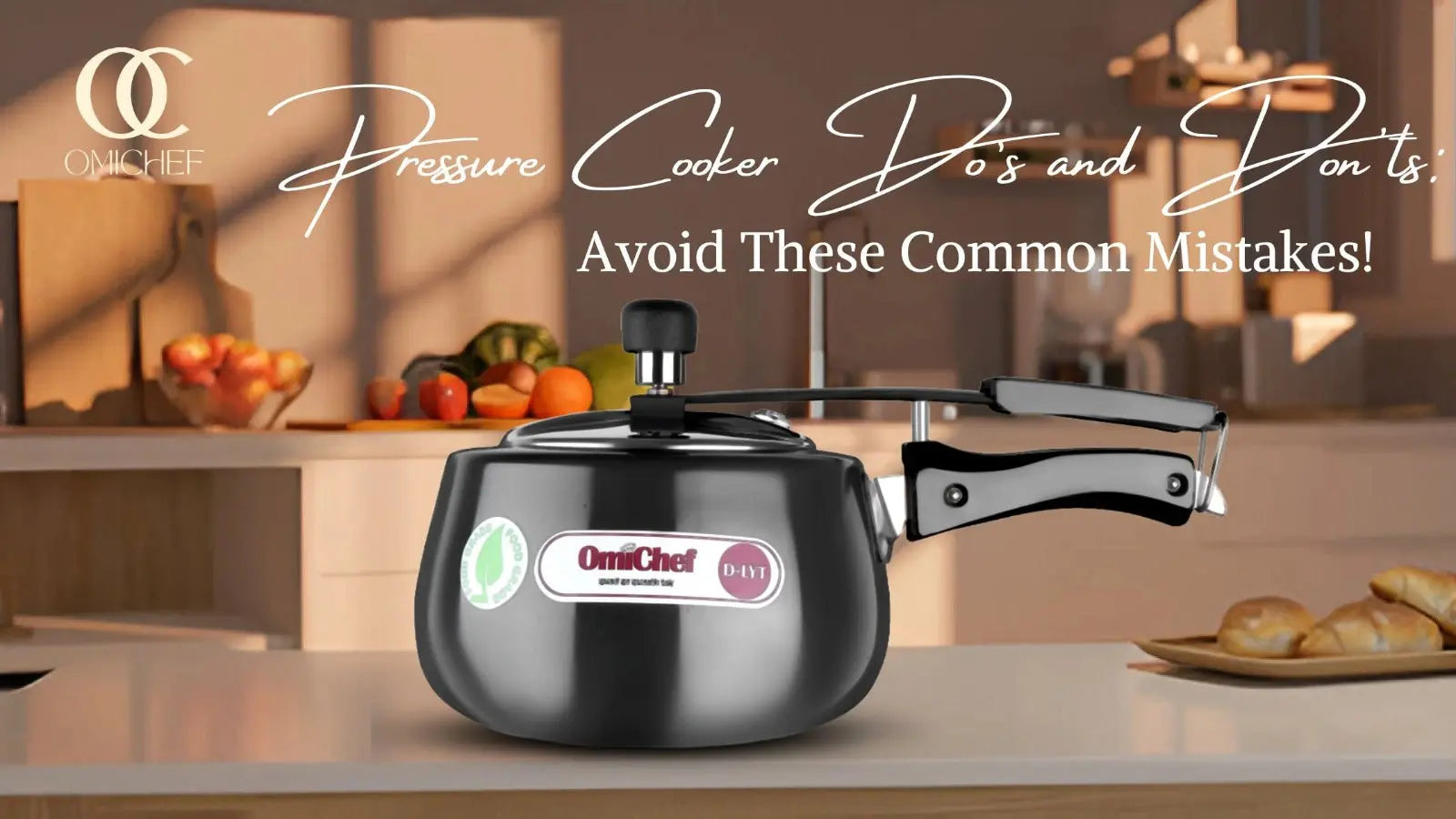Introduction
Pressure cookers are a fantastic kitchen tool that can save time and produce delicious, tender meals. However, despite their efficiency, many home cooks encounter common problems when using them. From overfilled pots to improperly sealed lids, these issues can lead to undercooked food, safety hazards, and frustrating cooking experiences.
In this blog post, we will explore the essential dos and don’ts of pressure cooking to help you avoid these common pitfalls. Whether you're a seasoned pro or new to pressure cooking, understanding these key tips will ensure your meals come out perfect every time and keep your cooking experience hassle-free.
Pressure Cooker Dos and Don'ts by Omichef.
Do: Always Check the Sealing Ring Before Cooking.
Before you start cooking with your pressure cooker, it’s crucial to check the sealing ring. The sealing ring is a rubber or silicone ring that sits around the edge of the lid. Its job is to create a tight seal between the lid and the pot, which keeps the steam inside and helps the pressure build up.
If the sealing ring is damaged or not properly fitted, your pressure cooker won’t build enough pressure. This can lead to uneven cooking, undercooked food, and even potential spills. To avoid these problems, always inspect the sealing ring before you start cooking. Make sure it’s clean, free of cracks, and seated correctly in its groove. This simple step helps ensure your meals cook evenly and safely, giving you great results every time.
Don’t: Overfill the Pressure Cooker with Food or Liquid
When using a pressure cooker, it's important not to overfill it with food or liquid. Overfilling can cause several problems:
- Improper Cooking: If the pot is too full, there might not be enough space for steam to circulate properly. This can lead to uneven cooking, where some parts of your food are overcooked while others remain undercooked.
- Safety Hazards: Pressure cookers need space for steam to build up and create the necessary pressure for cooking. If the pot is overfilled, there’s a risk that food or liquid could block the vent or valve, leading to a dangerous buildup of pressure.
- Spills and Messes: Excess food or liquid can spill out of the pressure cooker during cooking, especially if it's bubbling vigorously. This can make a mess on your stove and potentially damage the cooker.
To avoid these issues, follow the manufacturer’s guidelines on the maximum fill line and leave enough space for steam to circulate. This helps ensure that your food cooks properly and that your pressure cooker operates safely.
Do: Adjust Cooking Time Based on Ingredients
One of the keys to successful pressure cooking is adjusting the cooking time based on the ingredients you're using. Different foods require different amounts of time to cook properly under pressure:
- Meats: Tough cuts of meat, like beef stew or pork shoulder, need more time to become tender compared to quicker-cooking cuts like chicken breasts. For example, beef stew might need around 35-40 minutes, while chicken breasts might only need 10-15 minutes.
- Vegetables: Hard vegetables like potatoes and carrots take longer to cook than softer vegetables like bell peppers or spinach. Hard vegetables usually need about 5-10 minutes, while softer ones may only need 1-3 minutes.
- Grains and Legumes: Foods like beans, lentils, and rice also vary in cooking time. Beans can take anywhere from 20-40 minutes depending on their type, while rice typically cooks in about 5-7 minutes.
Adjusting cooking times ensures that all your ingredients are cooked evenly and to the right texture. If you are cooking a dish with a mix of ingredients, it’s often best to add items that need more time at the beginning and quicker-cooking ingredients later on. This way, you get perfectly cooked meals every time!
Don’t: Force Open the Lid Before Pressure is Fully Released
Never try to open the pressure cooker lid before the pressure is completely released. Doing so can be very dangerous because the hot steam inside is under high pressure and can cause serious burns. To safely release pressure, first turn off the heat and let the cooker sit until the pressure naturally decreases. You can also use the quick-release method if your recipe calls for it, but always follow the manufacturer’s instructions. Waiting for the pressure to drop ensures that you can open the lid safely and avoid accidents.
Do: Regularly Clean the Vent Pipe and Pressure Valve
Make sure to clean the vent pipe and pressure valve of your pressure cooker regularly. These parts help release steam and keep the pressure safe. If they get clogged with food or dirt, they might not work properly, which can be dangerous. To keep everything working well and safely, clean these parts after each use. It’s a quick and easy way to prevent problems and make sure your pressure cooker stays in good shape.
Don’t: Skip the Natural Release for Certain Dishes
For some recipes, it's important to let the pressure release naturally rather than using the quick-release method. Natural release means letting the pressure decrease on its own after cooking, which can take 10-20 minutes. This method is especially useful for dishes with starchy ingredients like beans or grains, as it helps them finish cooking gently and prevents them from becoming mushy. It also helps to avoid splatters and ensures flavors meld well. Skipping this step can lead to unevenly cooked food or messes, so follow your recipe's instructions for the best results.
Do: Use the Right Amount of Liquid for Effective Pressure Cooking
Always use the right amount of liquid when cooking with a pressure cooker. The liquid is essential because it creates steam, which builds up pressure inside the cooker and cooks your food. Without enough liquid, your pressure cooker can’t generate enough pressure, leading to undercooked food or even damage to the cooker. Most recipes will specify how much liquid you need, so make sure to follow these instructions. Generally, you will need at least 1 cup of liquid, but check your pressure cooker's manual for exact requirements. Using the proper amount of liquid ensures that your food cooks evenly and your pressure cooker works safely and effectively.
Don’t: Use a Pressure Cooker on High Heat Throughout the Cooking Process
Don’t keep your pressure cooker on high heat the entire time. Start with high heat to build up pressure quickly, then lower the heat to maintain a steady pressure. Using high heat throughout can cause food to cook too fast, leading to uneven results and potential burning. Reducing the heat once the pressure is reached helps cook your food evenly and safely, giving you better results and preventing accidents.

Conclusion
Mastering the art of pressure cooking can transform your kitchen experience, making meal preparation quicker and more enjoyable. By following these essential do’s and don’ts, you Will avoid common pitfalls and ensure your dishes turn out perfectly every time.
At Omichef, we understand the importance of reliable and high-quality cookware. Our range of pressure cookers is designed to make your cooking journey seamless and satisfying.
Ready to elevate your cooking? Visit our website OmiChef today to explore our premium pressure cookers and other kitchen essentials. Don’t miss out on making your meals effortless and delicious—shop now and experience the Omichef difference!

